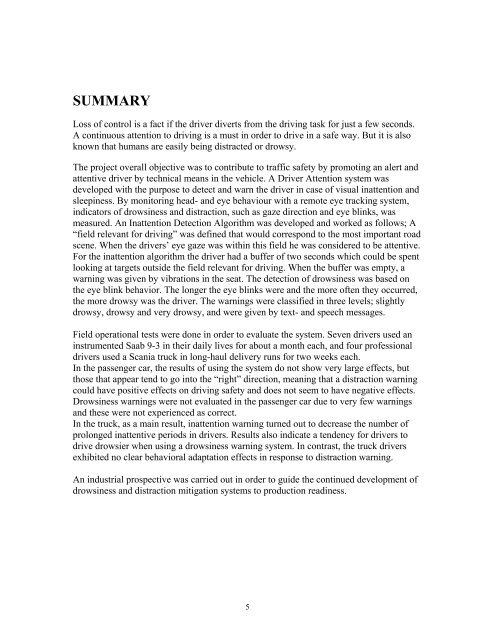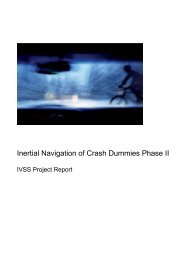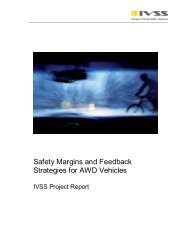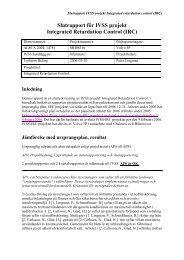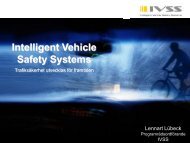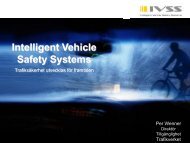7. Fulfilment of IVSS objectives - IVSS Intelligent Vehicle Safety ...
7. Fulfilment of IVSS objectives - IVSS Intelligent Vehicle Safety ...
7. Fulfilment of IVSS objectives - IVSS Intelligent Vehicle Safety ...
You also want an ePaper? Increase the reach of your titles
YUMPU automatically turns print PDFs into web optimized ePapers that Google loves.
SUMMARY<br />
Loss <strong>of</strong> control is a fact if the driver diverts from the driving task for just a few seconds.<br />
A continuous attention to driving is a must in order to drive in a safe way. But it is also<br />
known that humans are easily being distracted or drowsy.<br />
The project overall objective was to contribute to traffic safety by promoting an alert and<br />
attentive driver by technical means in the vehicle. A Driver Attention system was<br />
developed with the purpose to detect and warn the driver in case <strong>of</strong> visual inattention and<br />
sleepiness. By monitoring head- and eye behaviour with a remote eye tracking system,<br />
indicators <strong>of</strong> drowsiness and distraction, such as gaze direction and eye blinks, was<br />
measured. An Inattention Detection Algorithm was developed and worked as follows; A<br />
“field relevant for driving” was defined that would correspond to the most important road<br />
scene. When the drivers’ eye gaze was within this field he was considered to be attentive.<br />
For the inattention algorithm the driver had a buffer <strong>of</strong> two seconds which could be spent<br />
looking at targets outside the field relevant for driving. When the buffer was empty, a<br />
warning was given by vibrations in the seat. The detection <strong>of</strong> drowsiness was based on<br />
the eye blink behavior. The longer the eye blinks were and the more <strong>of</strong>ten they occurred,<br />
the more drowsy was the driver. The warnings were classified in three levels; slightly<br />
drowsy, drowsy and very drowsy, and were given by text- and speech messages.<br />
Field operational tests were done in order to evaluate the system. Seven drivers used an<br />
instrumented Saab 9-3 in their daily lives for about a month each, and four pr<strong>of</strong>essional<br />
drivers used a Scania truck in long-haul delivery runs for two weeks each.<br />
In the passenger car, the results <strong>of</strong> using the system do not show very large effects, but<br />
those that appear tend to go into the “right” direction, meaning that a distraction warning<br />
could have positive effects on driving safety and does not seem to have negative effects.<br />
Drowsiness warnings were not evaluated in the passenger car due to very few warnings<br />
and these were not experienced as correct.<br />
In the truck, as a main result, inattention warning turned out to decrease the number <strong>of</strong><br />
prolonged inattentive periods in drivers. Results also indicate a tendency for drivers to<br />
drive drowsier when using a drowsiness warning system. In contrast, the truck drivers<br />
exhibited no clear behavioral adaptation effects in response to distraction warning.<br />
An industrial prospective was carried out in order to guide the continued development <strong>of</strong><br />
drowsiness and distraction mitigation systems to production readiness.<br />
5


